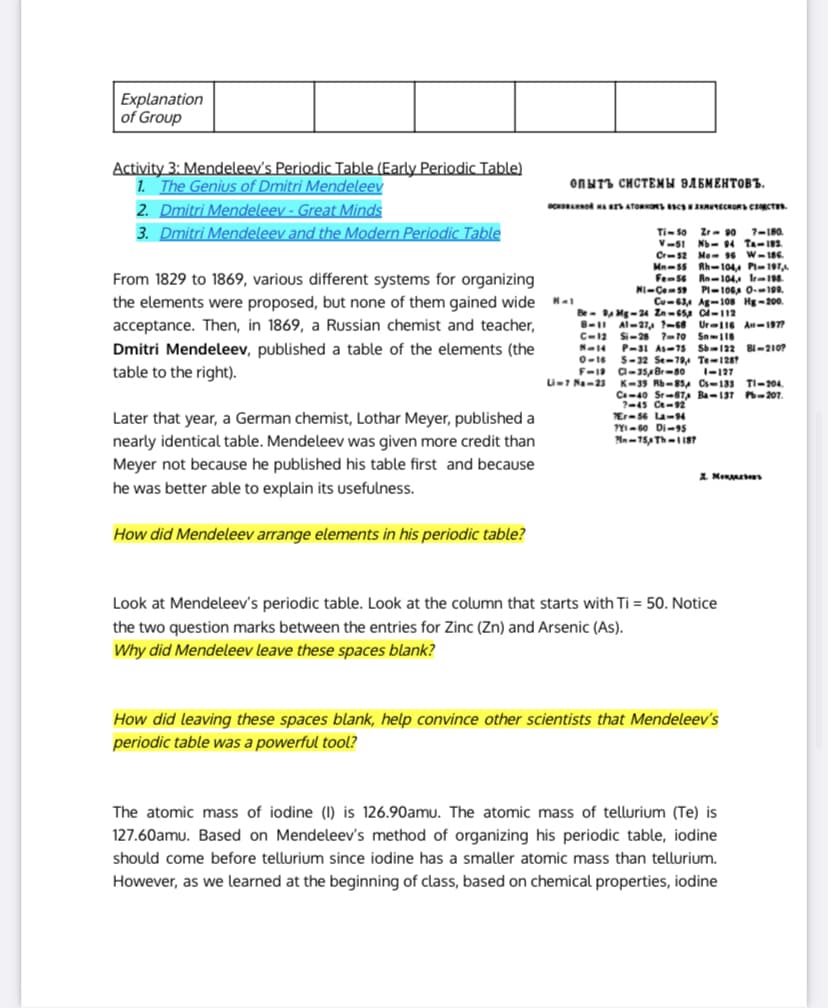2. Dmitri Mendeleev - Great Minds 3. Dmitri Mendeleev and the Modern Periodic Table Ti-s0 Mn-55 Fes NI-Ce9 Ce- Be- A Mg-24 Za-65 8-I Al-27a 1-8 C-12 Si-28 -10 P-31 As-75 0-16 S-32 Se-19 F-ID a-35 Br-s0 U-7 Na-23 K-39 R-SA Ca40 Sr-8T 7-45 C-2 TEr-56 La-14 m-0 Di-95 From 1829 to 1869, various different systems for organizing the elements were proposed, but none of them gained wide acceptance. Then, in 1869, a Russian chemist and teacher, Dmitri Mendeleev, published a table of the elements (the N-14 table to the right). Later that year, a German chemist, Lothar Meyer, published a nearly identical table. Mendeleev was given more credit than Meyer not because he published his table first and because he was better able to explain its usefulness. How did Mendeleev arrange elements in his periodic table? Look at Mendeleev's periodic table. Look at the column that starts with Ti = 50. No the two question marks between the entries for Zinc (Zn) and Arsenic (As). Why did Mendeleev leave these spaces blank? How did leaving these spaces blank, help convince other scientists that Mendele periodic table was a powerful tool?
2. Dmitri Mendeleev - Great Minds 3. Dmitri Mendeleev and the Modern Periodic Table Ti-s0 Mn-55 Fes NI-Ce9 Ce- Be- A Mg-24 Za-65 8-I Al-27a 1-8 C-12 Si-28 -10 P-31 As-75 0-16 S-32 Se-19 F-ID a-35 Br-s0 U-7 Na-23 K-39 R-SA Ca40 Sr-8T 7-45 C-2 TEr-56 La-14 m-0 Di-95 From 1829 to 1869, various different systems for organizing the elements were proposed, but none of them gained wide acceptance. Then, in 1869, a Russian chemist and teacher, Dmitri Mendeleev, published a table of the elements (the N-14 table to the right). Later that year, a German chemist, Lothar Meyer, published a nearly identical table. Mendeleev was given more credit than Meyer not because he published his table first and because he was better able to explain its usefulness. How did Mendeleev arrange elements in his periodic table? Look at Mendeleev's periodic table. Look at the column that starts with Ti = 50. No the two question marks between the entries for Zinc (Zn) and Arsenic (As). Why did Mendeleev leave these spaces blank? How did leaving these spaces blank, help convince other scientists that Mendele periodic table was a powerful tool?
Chapter16: Applications Of Neutralization Titrations
Section: Chapter Questions
Problem 16.39QAP
Related questions
Concept explainers
Atomic Structure
The basic structure of an atom is defined as the component-level of atomic structure of an atom. Precisely speaking an atom consists of three major subatomic particles which are protons, neutrons, and electrons. Many theories have been stated for explaining the structure of an atom.
Shape of the D Orbital
Shapes of orbitals are an approximate representation of boundaries in space for finding electrons occupied in that respective orbital. D orbitals are known to have a clover leaf shape or dumbbell inside where electrons can be found.
Question
100%
I need help thank you!

Transcribed Image Text:| Explanation
of Group
Activity 3: Mendeleev's Periodic Table (Early Periodic Table)
1. The Genius of Dmitri Mendeleev
2. Dmitri Mendeleev - Great Minds
3. Dmitri Mendeleev and the Modern Periodic Table
ONNT3 CHCTEMH BAEMEHTOBB.
OCA ATORONS CSENNECKORSCCT
Ti- so Zr- 90 7-180.
V-51 N- 4 Ta-182
Cr-s2 Me- 6
Mn-55
Fems6 Rn-104. Ir-1.
W-186.
Rh-104,4 P-197
From 1829 to 1869, various different systems for organizing
NI-Ce59
PI-106A 0-190.
the elements were proposed, but none of them gained wide
acceptance. Then, in 1869, a Russian chemist and teacher,
Cu-63A Ag-108 Hg-200.
Be- A Mg-24 Zn-65 C-112
B-I Al-27, ?-68 Ur-I16 An-1977
C-12
N-14
0-16 S-32 Se-794 Te-128
F-1 a-sBr-80
Si-28 ?-10 Sn-118
P-31 As-75 Sb-122 BI-210?
Dmitri Mendeleev, published a table of the elements (the
table to the right).
I-127
U-7 Na-23
TI-204.
K-39 Rb-85, Cs-133
Ca-40 Sr-8T, Ba-137 P-207.
?-45 Ce-92
Er-56 La-94
?YI- 60 Di-95
Later that year, a German chemist, Lothar Meyer, published a
nearly identical table. Mendeleev was given more credit than
Meyer not becaUse he published his table first and because
he was better able to explain its usefulness.
I Men s
How did Mendeleev arrange elements in his periodic table?
Look at Mendeleev's periodic table. Look at the column that starts with Ti = 50. Notice
the two question marks between the entries for Zinc (Zn) and Arsenic (As).
Why did Mendeleev leave these spaces blank?
How did leaving these spaces blank, help convince other scientists that Mendeleev's
periodic table was a powerful tool?
The atomic mass of iodine (1) is 126.90amu. The atomic mass of tellurium (Te) is
127.60amu. Based on Mendeleev's method of organizing his periodic table, iodine
should come before tellurium since iodine has a smaller atomic mass than tellurium.
However, as we learned at the beginning of class, based on chemical properties, iodine
Expert Solution
This question has been solved!
Explore an expertly crafted, step-by-step solution for a thorough understanding of key concepts.
This is a popular solution!
Trending now
This is a popular solution!
Step by step
Solved in 2 steps

Knowledge Booster
Learn more about
Need a deep-dive on the concept behind this application? Look no further. Learn more about this topic, chemistry and related others by exploring similar questions and additional content below.Recommended textbooks for you


Principles of Instrumental Analysis
Chemistry
ISBN:
9781305577213
Author:
Douglas A. Skoog, F. James Holler, Stanley R. Crouch
Publisher:
Cengage Learning


Principles of Instrumental Analysis
Chemistry
ISBN:
9781305577213
Author:
Douglas A. Skoog, F. James Holler, Stanley R. Crouch
Publisher:
Cengage Learning